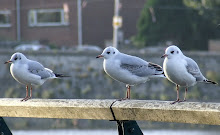The REAL "WAR HORSE"
I won't be going off to see the film 'War Horse'. Too upsetting! I've read too many WW1 books to get a gist of what I might see!
But I subscribe to emails from the Blue Cross, Britain's oldest animal charity. They did a lot of work for the horses that were used in the First World War and have released some videos/slide shows on their work.
Here are a couple they forwarded me today. I hope you find them interesting.....
This one is from Pip Dodd, curator at the National Army Museum. He explains the role of the horses in the war, with some photo's from the time:
In this one a woman tells a story about her grandfather, a 'driver' in the war, which meant he looked after the horses. The tale includes how he would risk his own life for the sake of a horse, and was awarded a medal for his bravery.
If you ARE interested in the film, I urge you to find out more from the National Army Museum's exhibition pages: WAR HORSE, Fact & Fiction, click on 'exhibition themes, about half way down the page.
There are also links to scenes behind the stageplay, and how the puppets in the play were made.
I recently read an interview with Michael Morpurgo about his book. He said that about 1 million horses were sent to war. The National War Museum puts it at nearer 6 million. He says that 67000 came home. This was nearer 165,000, but they didn't simply all return. The best horses were brought back to Britain and sold, to make money to cover some of the army's debts. The less healthy ones were left behind in France and Belgium, and sold to farmers there, to work out their lives on the farms.
If we humans need to blow each other up periodically, I wish we would find a way of doing it without hurting animals, completely innocent in our stupid wars. That we've put them to use in our slaughter feels nothing less than obscene.
I like this memorial in Port Elizabeth, Eastern Cape, South Africa:
This memorial, designed by Joseph Whitehead and cast in bronze by Thames Dillon Works in Surrey, was unveiled on 11 February 1905 by the Mayor of Port Elizabeth, Mr Alexander Fettes. The monument commemorates the horses that suffered and died during the Anglo-boer War (1899-1902). ...consisting of life-sized bronze figures of a horse about to quench its thirst from a bucket held by a kneeling soldier, together with the inscribed granite plinth on which it stands and the base of which incorporates a drinking trough.
I like the way the man is kneeling down, making himself lower than the horse.
Maybe we need a few more memorials like this, to remind us that it isn't just ourselves that get hurt when all the flag waving starts.
































9 comments:
Well said Helena!! Got me with tears in my eyes here :( Love, Di xx
You know what? I completely agree with you....
Thank you for posting this, Helena.
We humans have the responsibility to treat all other species with whom we share a place on this little planet, with the dignity they deserve, and our gratitude for their very existence, and even more gratitude when we use them as 'beasts of burden' or for food or for the range of awesome companionship we have with them as our pets. They deserve so much better than they are often given. And oh, how much we receive from them!
Wonderful movies. And thank you for your words, well said.
I'm with you on this one. They train dolphins to carry submarine mines and dogs to search for land mines too.
It's wrong.
THis is a wonderful post, Helena. Movies tend to gloss over a lot of the real facts. This brings the truth to light!
Totally agree.
Dxxx
Great post, Helena. We do some terrible things to animals. I just had a read on Wikipedia about horses in World War One too - amazing and terrible.
Well said, Helena.
A terrific truthful post Helena.
Post a Comment